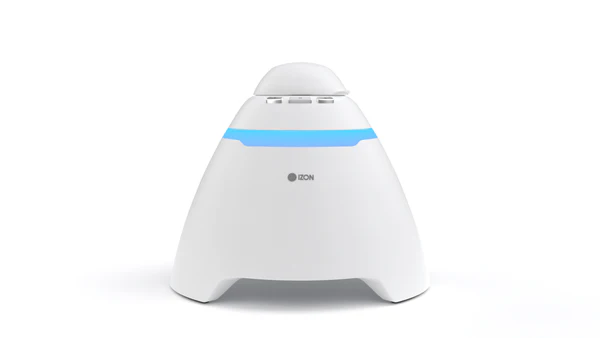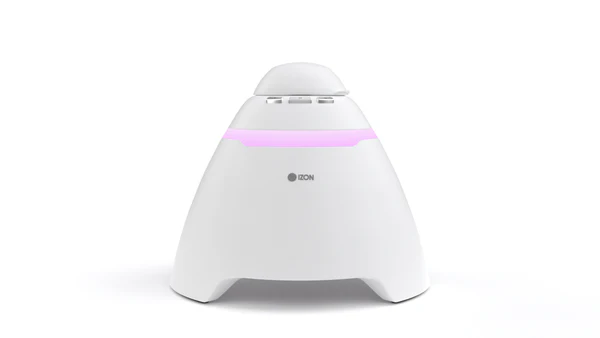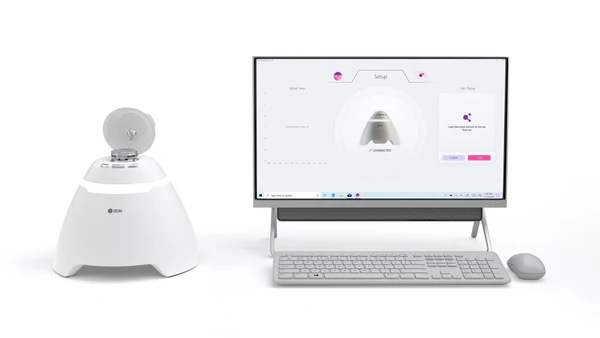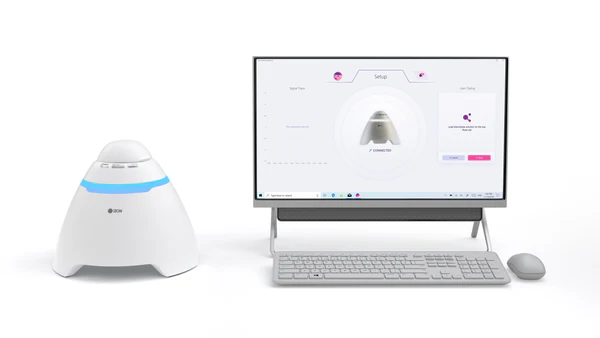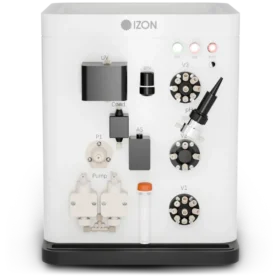The Exoid is Izon’s latest instrument for measuring the physical characteristics of nanoparticles in solution. Based on principles of Tunable Resistive Pulse Sensing (TRPS), the Exoid enables precise measurements of particle size, concentration and zeta potential, using a suitably sized nanopore that enables measurements within a defined size range. The uniquely high-resolution data that can be obtained using the Exoid enables you to compare your samples with confidence.
What is Tunable Resistive Pulse Sensing (TRPS)?
Tunable Resistive Pulse Sensing (TRPS) is a single-particle measurement technique designed for measuring nanoparticles in the size range of 40 nm to 11 µm.
TRPS monitors current flow through a tunable nanopore. Particles crossing the nanopore cause transient changes in the flow of an ionic current, which can be detected and analysed via the resulting blockades. Each particle size is determined for individual particles; blockade magnitude is proportional to particle size, and particle concentration is calculated from the particle flow rate measured at several different applied pressures. Zeta potential (a measure of the effective surface charge) is derived by measuring electrophoretic mobility, which is calculated based on the speed at which the particle traverses the nanopore.
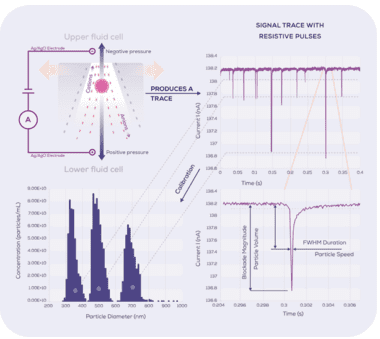
Unlike ensemble techniques such as the dynamic light scattering (DLS), where larger particles can skew size measurements, the Exoid provides insightful, high-resolution measurements that allow you to detect important differences in particle size distribution. Given the wide size range that can be analysed using different sized nanopores, TRPS has been adopted for use across a range of disciplines and industries. The Exoid is suited for use in the analysis of nanoparticles including exosomes and other extracellular vesicles, lipid nanoparticles, virus-like particles, and monoclonal antibody preparations.
Why Choose TRPS Over NTA?
In contrast with the true single-particle nature of TRPS, Nanoparticle Tracking Analysis (NTA) uses the tracking of particle motion via light scattering to assess the mean squared displacement of particles moving under Brownian motion, in a sample chamber illuminated by a laser beam. Particle concentration calculations are based on the number of particles tracked in an estimated illumination volume. The resolution capabilities of NTA are also relatively lower that TRPS.
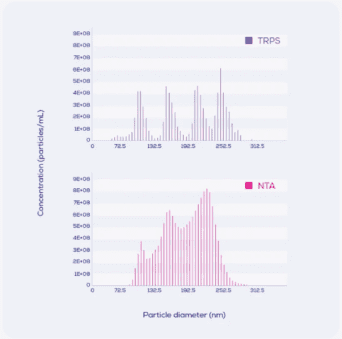
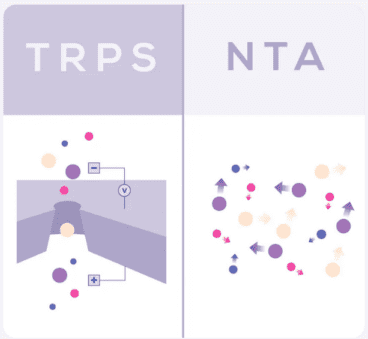
Particle size distribution of a quadrimodal mixture. TRPS (top) has a better resolution capability compared to NTA (bottom).
What is Tunable Resistive Pulse Sensing (TRPS)? (youtube.com)
Specification:
- Analysis range: 40 nm to 11 µm
- Concentration range: 1E5 to 1E11 particles/mL (size-dependent)
- Compatible electrolyte solutions: Include PBS, HEPES, MES and KCI
- Weight: 10.8 kg
- Footprint: 300 x 300 mm
- Height: 250 mm
- Certification: ISO 13485:2016
How do I incorporate TRPS in my research?
You may purchase the Exoid or get in touch with us ([email protected]) to discuss a lease agreement.
Reference Publications
Turkki, Vesa et al.
Experimental Evaluation of an Interferometric Light Microscopy Particle Counter for Titering and Characterization of Virus Preparations
Viruses vol. 13,5 939.
DOI: 10.3390/v13050939
Article Snippet: Highlight from the table3 “Tunable Resistive Pulse Sensing
(TRPS) qNano qViro-X Exoid (IZON Science Ltd.)”
J. Nathaniel Diehl, Amelia Ray, et al.
Measurement of Extracellular Vesicles with Tunable Resistive Pulse Sensing
PLOS ONE 18(4): e0284875.
DOI: https://doi.org/10.1371/journal.pone.0284875
Article Snippet: “This protocol uses the IZON qNano Gold TRPS instrument. If other TRPS measurement systems are used (e.g. IZON Exoid), this workflow will likely need to be adjusted slightly to incorporate alternate equipment.”
Norbert Moldovan, Sandra Verkuijlen, et al.
Circulating extracellular vesicles in lung cancer patients are not enriched in tumor-derived DNA fragments as revealed by whole genome sequencing
bioRxiv 2022.07.22.501161
DOI: https://doi.org/10.1101/2022.07.22.501161
Article Snippet: “Particle analysis using Exoid (iZON), based on tunable-resistive pulse sensing (TRPS), confirmed that fractions 1-5 are enriched in small particles with a mean size distribution of ∼144 nm, matching the EM images.”
Sanoji Wijenayake
Milk-derived extracellular vesicles attenuate pro-inflammation and inflammasome activation in the microglia
Volume12, Issue S1, May 2023, e12329
DOI: https://doi.org/10.1002/jev2.12329
Article Snippet: “MEV concentration, size, and particle distribution were measured via tunable resistive pulse sensing (TRPS) technology (IZON: The Exoid).”
Van Bavel N, Issler T, Pang L, Anikovskiy M, Prenner EJ.
A Simple Method for Synthesis of Chitosan Nanoparticles with Ionic Gelation and Homogenization
Molecules. 2023; 28(11):4328.
DOI: https://doi.org/10.3390/molecules28114328
Article Snippet: “The above procedure was replicated four times and samples were measured across two facilities with different characterization instruments, including DLS at University of Calgary and Tunable Resistive Pulse Sensing (TRPS) with Exoid-034 at IZON Science (Christchurch, New Zealand). Results were strikingly similar.”

